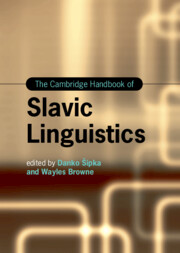Book contents
- The Cambridge Handbook of Slavic Linguistics
- Cambridge Handbooks in Language and Linguistics
- The Cambridge Handbook of Slavic Linguistics
- Copyright page
- Contents
- Figures
- Tables
- Contributors
- Introduction
- Part 1 Prosody and Phonology
- 1 Word Stress
- 2 Vocalism: The Vowels
- 3 Consonantism: The Consonants
- 4 Syllable Structure
- 5 Phonologically Conditioned Alternations
- 6 Prosodic Reflexes of Information Structure
- Part 2 Inflectional and Derivational Morphology
- Part 3 Syntax
- Part 4 Lexicon
- Part 5 Sociolinguistic and Geographical Approaches
- Part 6 Experimental and Quantitative Approaches
- Name Index
- Subject Index
- References
2 - Vocalism: The Vowels
from Part 1 - Prosody and Phonology
Published online by Cambridge University Press: 16 May 2024
- The Cambridge Handbook of Slavic Linguistics
- Cambridge Handbooks in Language and Linguistics
- The Cambridge Handbook of Slavic Linguistics
- Copyright page
- Contents
- Figures
- Tables
- Contributors
- Introduction
- Part 1 Prosody and Phonology
- 1 Word Stress
- 2 Vocalism: The Vowels
- 3 Consonantism: The Consonants
- 4 Syllable Structure
- 5 Phonologically Conditioned Alternations
- 6 Prosodic Reflexes of Information Structure
- Part 2 Inflectional and Derivational Morphology
- Part 3 Syntax
- Part 4 Lexicon
- Part 5 Sociolinguistic and Geographical Approaches
- Part 6 Experimental and Quantitative Approaches
- Name Index
- Subject Index
- References
Summary
Until the very early Middle Ages, Slavic vocalism developed uniformly. Later it began to diversify. Causes of diversification included territorial dispersion and occupation of areas where non-Slavic tribes lived or where Slavs neighboured non-Slavs. Some areas retained archaic features; others began to develop innovations. Hence, smaller intersecting areas often arose with particular features. In addition to the five mandatory vowel segments, Slavic languages have additional regional segments. We distinguish at least the following: an area with phonological long vowels; the western periphery with diphthongs and additional intermediate segments between /i/ and /e/ and between /u/ and /o/; an area with additional central vowels; one with distinctive tonal features; one with reduction of unstressed vowels; areas with traces of nasal vowels; an area with a glottal stop; one with high frequency of vowel clusters (while the frequency ratio of vowels to consonants in text does not vary much).
Keywords
- Type
- Chapter
- Information
- The Cambridge Handbook of Slavic Linguistics , pp. 29 - 44Publisher: Cambridge University PressPrint publication year: 2024

